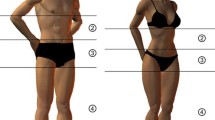Abstract
The study of bodily attractiveness is important to evolutionary psychology and contributes more generally to an understanding of beauty. The fundamental questions within this literature are: how do we judge bodily beauty, and what are the physical cues for bodily attractiveness? And finally, are these cues related to health and reproduction? This chapter reviews past works on bodily attractiveness, introduces a new body index — the volume-height index (VHI) — and discusses the influence of VHI and other body parameters on bodily attractiveness.
Access this chapter
Tax calculation will be finalised at checkout
Purchases are for personal use only
Preview
Unable to display preview. Download preview PDF.
Similar content being viewed by others
References
DeRidder, C. M., Bruning, P. F., Zonderland, M. L., Thijssen, J. H. H., Bonfrer, J. M. G., Blankenstein, M. A., et al. (1990). Body fat mass distribution, and plasma hormones in early puberty in females. Journal of clinical Endocrinological and Metabolism, 70, 888–893.
Fan, J. T., Yu, W., & Hunter, L. (2004). Clothing appearance and fit: Science and technology. Cambridge: Woodhead Publishing Limited.
Fan, J. T., Dai, W., Liu, F., & Wu, J. (2005). Visual perception of male body attractiveness. Proceedings of Royal Society of London Series B, 272, 219–226.
Fan, J. T., Liu, F., Wu, J., & Dai, W. (2004). Visual perception of female physical attractiveness. Proceedings of the Royal Society London B, 271, 347–352.
Fan, J., Dai, W., Qian, X., Chau, K. P., & Liu, Q. (2006). Effects of shape parameters on female body attractiveness. Unpublished manuscript.
Folsom, A. R., Kaye, S. A., Sellers, T. A., Hong, C., Cerhan, J. R., Potter, J. D., et al. (1993). Body fat distribution and 5-years risk of death in older women. Journal of the American Medical Association, 269, 483–487.
Furnham, A., Dias, M., & McClelland, C. (1998). The role of body weight, waist-to-hip ratio, and breast size in judgments of female attractiveness. Sex Roles, 39, 311–326.
Furnham, A., Tan, T., & McManus, C. (1997). Waist-to-hip ratio and preferences for body shape: A replication and extension. Personal and Individual Differences, 22, 539–549.
Gaut, B., & Lopes, D. M. (2001). The Routledge companion to aesthetics. London: Routledge.
Horn, M. J., & Gurel, L. M. (1981). The second skin (3rd ed.). Boston, MA: Houghton Mifflin Company.
Kopelman, P. G. (2000). Obesity as a medical problem. Nature, 404, 635–643.
Nasser, M. (1988). Culture and weight consciousness. Journal of Psychosomatic Research, 32, 573–577.
Singh, D. (1993a). Adaptive significationce of female physical attractiveness: Role of the waist-to-hip ratio. Journal of Personality and Social Psychology, 65, 293–307.
Singh, D. (1993b). Body shape and women’s attractiveness: The critical role of waist-to-hip ratio. Human Nature, 4, 297–321.
Singh, D. (1994a). Is thin really beautiful and good? Relationship between waist-to-hip ratio (WHR) and female attractiveness. Personality and Individual Differences, 16, 465–481.
Singh, D. (1994b). Body fat distribution and perception of desirable female body shape by young black men and women. International Journal of Eating Disorders, 16, 289–294.
Singh, D. (1995a). Female health, attractiveness and desirability for relationships: Role of breast asymmetry and WHR. Ethology and Sociobiology, 16, 465–481.
Singh, D. (1995b). Female judgement of male attractiveness and desirability for relationships: Role of waist-to-hip ratio and financial status. Journal of Personality and Social Psychology, 69, 1089–1101.
Smith, K. L., Cornelissen, P. L., & Tovée, M. J. (2007). Color 3D bodies and judgements of human female attractiveness. Evolution and Human behavior, 28, 48–54.
Swami, V., Einon, D., & Furnham, A. (2006). An investigation of the leg-to-body ratio as a human aesthetic criterion. Body Image, 3, 317–323.
Swami, V., Gray, M., & Furnham, A. (2007). The female nude in Rubens: Disconfirmatory evidence of the waist-to-hip ratio hypothesis of female physical attractiveness. Imagination, Cognition and Personality, 26, 139–147.
Thompson, J. K., Heinberg, L. J., Altabe, M., & Tantleff-Dunn, S. (1999). Exacting beauty: Theory, assessment, and treatment ofbody image disturbance. Washington, DC: American Psychological Association.
Tovée, M. J., & Cornelissen, P. L. (1999). The mystery of human beauty. Nature, 399, 215–216.
Tovée, M. J., & Cornelissen, P. L. (2001). Female and male perceptions of female physical attractiveness in front-view and profile. British Journal of Psychology, 92, 391–402.
Tovée, M. J., Maisey, D. S., Emery, J. L., & Cornelissen, P. L. (1999). Visual cues to female physical attractiveness. Proceedings of the Royal Society of London Series B, 266, 211–218.
Tovée, M. J., Hancock, P., Mahmoodi, S., Singleton, B. R. R., & Cornelissen, P. L. (2002). Human female attractiveness: Waveform analysis of body shape. Proceedings of the Royal Society of London Series B, 269, 2205–2213.
Treleaven, P., Furnham, A., & Swami, V. (2006). The science of body metrics. The Psychologist, 19, 416–419.
Winkelgren, I. (1998). Obesity: How big a problem? Science, 280, 1364–1367.
Yu, D. W., & Shepard, G. H. (1998). Is beauty in the eye of the beholder? Nature, 396, 321–322.
Zaadstra, B. M., Seidell, J. C., van Noord, P. A. H., te Velde, E. R., Habbema, J. D. F., Vrieswijk, B., et al. (1993). Fat and female fecundity: Prospective study of effect of body fat distribution on conception rates. British Medical Journal, 306, 484–487.
Author information
Authors and Affiliations
Editor information
Editors and Affiliations
Copyright information
© 2007 Jintu Fan
About this chapter
Cite this chapter
Fan, J. (2007). The Volume-Height Index as a Body Attractiveness Index. In: Swami, V., Furnham, A. (eds) The Body Beautiful. Palgrave Macmillan, London. https://doi.org/10.1057/9780230596887_3
Download citation
DOI: https://doi.org/10.1057/9780230596887_3
Publisher Name: Palgrave Macmillan, London
Print ISBN: 978-1-349-35664-5
Online ISBN: 978-0-230-59688-7
eBook Packages: Palgrave Social & Cultural Studies CollectionSocial Sciences (R0)



